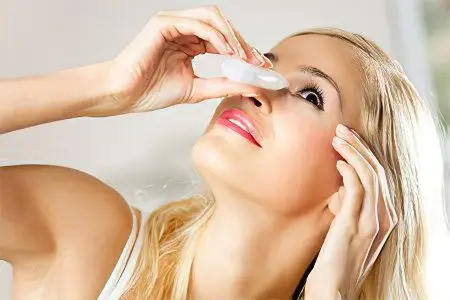Contents
What is Dry Eye Syndrome?
Dry eye syndrome (xerophthalmia) is a pathological condition characterized by insufficient hydration of the cornea and conjunctiva of the eyes due to instability of the tear film and tear fluid deficiency.
The anterior surface of a healthy eye is covered with a complete tear film approximately 10 µm thick.
This film protects the eyes from negative environmental influences, from dust and other small foreign bodies, and also supplies the cornea with nutrients and oxygen, creating a natural immune barrier to infections.
The tear film consists of 3 layers:

Mucinous layer – produced by the goblet cells of the conjunctiva and covers the cornea, making its surface smooth and even; its function is to hold the tear film on the corneal epithelium; the thickness of this layer is 0,02-0,05 microns, which is only 0,5% of the film thickness;
Water (watery) layer – produced by the lacrimal glands and consists of biologically active substances and dissolved electrolytes; is continuously renewed and supplies the epithelium of the cornea and conjunctiva with nutrients and oxygen, and also ensures the removal of carbon dioxide molecules, metabolic waste and dead epithelial cells. The thickness of this layer is approximately 7 microns, which is more than 90% of the tear film;
lipid layer – covers the outside of the aqueous layer and is produced by the meibomian glands; is responsible for sliding the upper eyelid and protecting the eyeball, prevents the evaporation of the aqueous layer and excessive heat transfer from its epithelium.
On average, once every 10 seconds, the tear film ruptures, prompting blinking, resulting in tear fluid renewal and film repair. Moving along the surface of the cornea, the eyelid evens out the tear film and cleanses the cornea from exfoliated epithelial cells and foreign inclusions. At the same time, blinking stimulates the production of tear fluid by the glands.
Within one minute, approximately 15% of the entire tear film is renewed, and 8% evaporates. Dry eye syndrome develops with frequent multiple tears in the tear film, resulting in excessive dryness of the cornea. The reasons for such gaps can be a variety of factors: too rapid evaporation of the film, impaired secretion of mucins, lipids and lacrimal fluid.
This syndrome is diagnosed in 10-20% of the population, and is more common in women (70% of cases). The frequency of the disease is in direct proportion to age: only 50% of cases fall on the age of up to 12 years. 42-43% of people with this syndrome notice a significant deterioration in vision, have difficulty reading.
Causes of dry eye syndrome

The syndrome develops with a lack and low quality of the lacrimal fluid. The reasons for this may be some diseases:
Autoimmune (connective tissue diseases, Sjögren’s syndrome);
Endocrine (endocrine ophthalmopotia);
Diseases of the hematopoietic system (malignant lymphoma);
Neurological (Parkinson’s disease);
infectious;
Pathology of the kidneys;
Skin diseases of autoimmune etiology (pemphigus).
In diseases of the connective tissue, its pathological growth leads to blockage of the excretory ducts of the lacrimal glands. At Sjögren’s syndrome the lacrimal glands themselves are affected, not only does the lacrimal fluid become deficient, but its composition also changes: it becomes more viscous and thick, loses its bactericidal properties. Concomitant symptoms of Sjögren’s syndrome are dry mouth and genitals, swelling of the salivary glands, and joint pain.
In a separate group, one can single out directly pathologies of the organs of vision of an inflammatory and other nature, as well as surgical interventions leading to destabilization of the tear film.:
Chronic conjunctivitis;
Neuroparalytic and neurotrophic keratitis;
Lagophthalmos;
Corneal plastic surgery and radial keratotomy;
Blepharoplasty.
Lagophthalmos – This is a pathology in which the eyelids do not close completely. For uniform lubrication of the eyeball with tear fluid, it is necessary that the eyes close completely.
The risk group includes people exposed to the following factors:
Long work at the computer, reading, watching TV, working with small details;
Exposure to dry warm air from heating systems and air conditioners;
Wrong choice and wearing of contact lenses;
Poor environmental conditions (in people living near megacities, in polluted air, dry eye syndrome is observed 4 times more often than in rural areas);
Avitaminosis, depletion of the body;
Long-term use of certain medicines;
Genetic predisposition;
Decrease in the frequency of blinking movements for the eyelids.
Also, menopause and pregnancy in women can be attributed here, since the dependence of the onset of dry eye syndrome on the level of estrogen in the blood has been revealed.
Dry air of heating systems provokes accelerated evaporation of liquid from the surface of the eyeball, so this syndrome is more typical for residents of cold climatic zones. Prolonged visual concentration on certain objects (monitor screen or other objects) leads to insufficient blinking frequency. Also, too rare blinking may be the result of a decrease in the sensitivity of the cornea. Wearing contact lenses greatly increases dry eyes.
Taking certain medications reduces the production of tear fluid. These include: hormonal contraceptives, corticosteroids, anesthetics, anticholinergics, antihistamines, and blood pressure medications.
Symptoms of dry eye syndrome

Symptoms have a bilateral development (that is, they appear immediately in both eyes).
Subjective symptoms include:
Dryness of the cornea;
Feeling of a foreign object, “sand in the eyes”;
Itching, burning, cramps (when the tear film breaks, the sensitivity of the cornea increases, the risk of allergic reactions increases);
Redness of the eyes (often dry eye syndrome is accompanied by the development of an inflammatory process, since the damaged tear film does not perform its bactericidal functions);
Sticking of the eyelids after sleep;
Blurred vision that disappears when blinking (renewal of the tear film eliminates its irregularities, which cause blurring of the image);
lacrimation;
Photophobia (increased sensitivity to light);
Pain, especially when instilled in the eyes.
Often these symptoms appear in an erased form. They are aggravated by being in dry and dusty air, in smoky rooms, in strong winds, after prolonged eye strain.
The objective signs of the syndrome are:
Reduction or disappearance of lacrimal menisci at the edges of the eyelids (which is a sign of moderate corneal-conjunctival xerosis);
The formation of conjunctival secretions in the form of threads of mucus;
Slight hyperemia of the conjunctiva.
Signs such as burning, pain, sensation of a foreign body in the eye, lacrimation and photophobia are non-specific, that is, they are also observed in some other eye diseases, but are also taken into account when making a diagnosis.
The consequences of the development of the syndrome
Even a mild form of dry eye syndrome requires adequate medical treatment to prevent serious and irreversible consequences, which can be as follows:
Infection of the tissues of the eye;
Corneal damage;
Formation of various erosions;
Partial or complete loss of vision.
Preventive measures include limiting the impact of external negative factors, timely treatment of internal diseases, rational nutrition and drinking enough fluids.
Treatment of dry eye syndrome

The diagnosis is based on the results of biomicroscopy, tear fluid analysis, conjunctival smear cytology, Schirmer and Norn tests (determining the rate of formation and evaporation of the tear film). For treatment, artificial tears are used, in some cases, surgical methods.
Eye drops
High viscosity products include Vidisik, Oftagel, Lacropos, Korneregel. During blinking, the gel consistency of the drops liquefies and moisturizes the cornea. Gels are laid behind the eyelid and are applied for a long time, 1 time in 1-2 days.
To relieve inflammation, which often accompanies dry eye syndrome, antibiotics and immunosuppressants can be prescribed: ointment with erythromycin or tetracycline (course 7-10 days), Restasis drops with cyclosporine, as well as hormonal drops Maxidex, Alrex, Oftan, Dexamethasone.
Surgery
The following methods are used as surgical treatment:
Obturation tear ducts (blockage with special microscopic silicone plugs for the accumulation of fluid on the surface of the cornea);
Corneal plastic surgery (performed with xerotic ulcers, perforation and necrosis of the cornea);
Lateral tarsorrhaphy (performed with lagophthalmos);
Salivary gland transplant into the conjunctival sac.
Author of the article: Degtyareva Marina Vitalievna, ophthalmologist, ophthalmologist









